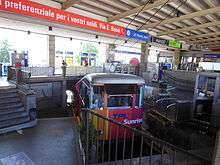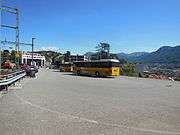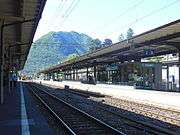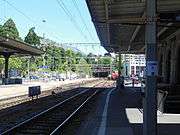Lugano railway station
Lugano | |||||||||||||||||||||||||||||||
|---|---|---|---|---|---|---|---|---|---|---|---|---|---|---|---|---|---|---|---|---|---|---|---|---|---|---|---|---|---|---|---|
|
Lugano main line station building. | |||||||||||||||||||||||||||||||
| Location |
Piazzale della Stazione, Lugano, Ticino, Switzerland | ||||||||||||||||||||||||||||||
| Coordinates | 46°00′19″N 08°56′48″E / 46.00528°N 8.94667°ECoordinates: 46°00′19″N 08°56′48″E / 46.00528°N 8.94667°E | ||||||||||||||||||||||||||||||
| Elevation | 335 m above the sea[1] | ||||||||||||||||||||||||||||||
| Owned by | Swiss Federal Railways | ||||||||||||||||||||||||||||||
| Operated by |
Swiss Federal Railways (SBB-CFF-FFS) Treni Regionali Ticino Lombardia (TILO) Eurocity (EC) Lugano–Ponte Tresa Railway (FLP) | ||||||||||||||||||||||||||||||
| Line(s) |
Gotthard Lugano–Ponte Tresa | ||||||||||||||||||||||||||||||
| Distance | 180.5 km (112.2 mi) from Immensee[1] | ||||||||||||||||||||||||||||||
| Connections |
Lugano Città–Stazione funicular Trasporti Pubblici Luganesi bus AutoPostale bus Autolinee Regionali Luganesi bus | ||||||||||||||||||||||||||||||
| History | |||||||||||||||||||||||||||||||
| Opened | December 6, 1874 | ||||||||||||||||||||||||||||||
| Electrified | February 6, 1922 | ||||||||||||||||||||||||||||||
| Services | |||||||||||||||||||||||||||||||
| |||||||||||||||||||||||||||||||
| Location | |||||||||||||||||||||||||||||||
 Lugano Lugano (Switzerland) | |||||||||||||||||||||||||||||||
Lugano railway station (Italian: Stazione di Lugano) is the main railway station of the city of Lugano, in the Swiss canton of Ticino. The station is on the Gotthard railway, and is also the terminus of the metre gauge Lugano–Ponte Tresa Railway (FLP) and the Lugano Città–Stazione funicular. The FLP terminus is across the station forecourt from the main line station, and is often regarded as a separate station, by the name of Lugano FLP.[1][2]
The station is situated on a hillside to the west of the city centre, overlooking the city and Lake Lugano, and the funicular provides a direct link from the station to the city centre below. The residential quarter of Besso lies above and to the west of the station.[3]
History
The Gotthard railway's station was opened in 1874, as part of that railway's Lugano to Chiasso line. By 1882, with the opening of the line across the Monte Ceneri Pass to Bellinzona, and the Gotthard Rail Tunnel beyond that, Lugano was connected with the rest of the canton of Ticino and with northern Switzerland.
The Lugano Città–Stazione funicular opened in 1886, and was followed by the Lugano–Tesserete railway (LT) in 1909, and the Lugano–Ponte Tresa railway (FLP) in 1912. The LT operated from a terminus and depot to the north-east of the main station, whilst the FLP constructed a terminus at a lower level to the south-east of the main station. Additionally, in 1910, a branch of the city's urban tramway was extended to the station forecourt.[4][5][6]
Until 1927 the station formed a barrier between the city to one side, and the suburb of Besso to the other. However, in that year a road tunnel and pedestrian subway were constructed under the railway, which allowed the extension of the city's trams to Besso. In 1943, Piazzale di Besso was created to the west of the station.[7]
The Lugano tramway closed in the 1950s. The Lugano–Tesserete railway closed in 1967, and the site of its station is now occupied by the regional bus stop and turning circle at the northern end of the station forecourt. The first section of its trackbed now forms a pedestrian ramp down to Via S. Gottardo, and the site of its depot is a car park.[4]
Between 1990 and 1992, the Lugano FLP station was renovated and expanded. The street level building is now a restaurant, although the platforms remain in use at the lower level.[8]
In 1998, a project to was initiate to improve the railway station facilities and the surrounding areas, designed by the architect Aurelio Galfetti. This has included the redevelopment of the forecourt of the station, especially in terms of pedestrian safety. In 2007 the station underpass was restored, and a third (northern) platform constructed, which allows access to the station from the north.
Facilities
The main line station is owned and operated by the Swiss Federal Railways. It contains four tracks, arranged with flanking side platforms and a central island platform. The main station buildings are on the platform on the city centre side of the station, but there is also access from the Besso side of the station to the adjacent platform. Both of these platforms, and the island platform between them, are linked by two pedestrian underpasses.[9]
In front of the station is a large forecourt, from which traffic other than buses and taxis is excluded. Local buses of the Trasporti Pubblici Luganesi (TPL) operate from the southern end of the forecourt, whilst regional buses of the AutoPostale and Autolinee Regionali Luganesi operate from the northern end. The station to city funicular, also operated by TPL, runs from a platform directly adjacent to the main station building, descending in tunnel under the forecourt.[9]
Across the forecourt from, and at a lower level to, the main station, is the eastern terminus of the metre gauge Lugano–Ponte Tresa Railway. The street level station building of this terminus is now a restaurant.[1][2][9]
The station does not include any freight handling facilities. Freight in the Lugano area is handled through the Lugano Vedeggio freight yard, constructed in the 1970s and accessed via a branch from the Gotthard railway near Taverne-Torricella station.[1]
|
Operations
Located near the southern end of the Gotthard railway, the main line station is served by long distance trains from northern Switzerland, principally Zurich and Basel, including Eurocity trains to Milan in Italy. It is also served by trains on line S10 of the Treni Regionali Ticino Lombardia (TILO), which operate every half-hour between Bellinzona, Lugano and Chiasso, with some trains extending northwards to Airolo and southwards to Milan.[1][2][10]
The Lugano–Ponte Tresa Railway (FLP) station is served by trains on line S60 of the FLP, which operate every 15 minutes between Lugano and Ponte Tresa, with trains every 30 minutes at weekends and evenings.[11][12]
The Lugano Città–Stazione funicular, one of Switzerland's busiest funicular lines, runs continuously from 05:20 to 23:50, seven days a week.[5]
Selected city bus routes of the Trasporti Pubblici Luganesi (TPL), and some regional routes of the AutoPostale and Autolinee Regionali Luganesi (ARL), serve the station. However the main hubs of Lugano's bus network are elsewhere, with TPL and ARL serving a city centre bus station a few minutes walk from the lower terminus of the funicular, and AutoPostale using an underground bus station to the north of the city centre.
|
References
- 1 2 3 4 5 6 Eisenbahnatlas Schweiz. Verlag Schweers + Wall GmbH. 2012. p. 59. ISBN 978-3-89494-130-7.
- 1 2 3 Moser, Beat; Pfeiffer, Peter (2004). SBB Gotthardbahn (in German). Fürstenfeldbruck, Germany: Eisenbahn-Journal (Verlagsgruppe Bahn GmbH). ISBN 3-89610-121-8.
- ↑ map.geo.admin.ch (Map). Swiss Confederation. Retrieved 2012-06-29.
- 1 2 "Lugano–Tesserete". www.eingestellte-bahnen.ch (in German). Retrieved 2012-10-26.
- 1 2 "TPL - Funicolare Lugano - Stazione" (in Italian). Trasporti Pubblici Luganesi SA. Retrieved 2012-09-05.
- ↑ "Storia" [History] (in Italian). FLP. Retrieved 2012-10-18.
- ↑ "Storia del quartiere di Besso" [History of Besso] (in Italian). City of Lugano. Retrieved 2012-10-29.
- ↑ "Cenni Storici Sulla Ferrovia Lugano-Ponte Tresa - 1981-2012" [History of the Lugano–Ponte Tresa railway - 1981-2012] (in Italian). Ferrovie Luganesi. Retrieved 2012-10-24.
- 1 2 3 "Piano interno della stazione di Lugano" [Lugano station plan] (PDF) (in Italian). Swiss Federal Railways. Retrieved 2012-06-29.
- ↑ "Departures - Lugano Station" (PDF). Swiss Federal Railways. Retrieved 2012-06-29.
- ↑ "Fermata Lugano FLP" [Lugano FLP Departures] (PDF) (in Italian). FLP. Retrieved 2012-10-18.
- ↑ "Lugano–Ponte Tresa (Linea S60)" (PDF) (in Italian). Canton of Ticino. Archived from the original on 2012-10-23. Retrieved 2012-10-23.
External links
-
 Media related to Lugano railway station at Wikimedia Commons
Media related to Lugano railway station at Wikimedia Commons -
 Media related to Lugano FLP railway station at Wikimedia Commons
Media related to Lugano FLP railway station at Wikimedia Commons - Lugano station on Swiss Federal Railway's web site




